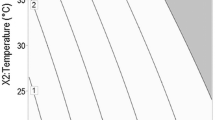Abstract
The quantitative study of heat treatments for sterilisation uses the Bigelow model to calculate the sterilising value (F). Calculation of F requires the previous determination of parameters D (decimal reduction time at experimental temperature) and Z (thermal-death time parameter), obtained from the thermal-death kinetics. Herein we compare two different methods, namely the Bigelow model and a predictive-type statistical method, to calculate the sterilisation effect against Bacillus coagulans spores when heat was applied to runner bean preserves (variety: Helda). Samples were subjected to various autoclave treatments at working temperatures (T ai) of 105, 107, 110, and 115°C for periods from 3 to 35 min. The microorganism used was B. coagulans. Sterilisation achieved by these autoclave treatments was determined by using the equation based on the Bigelow model (n probe = F z Ti/D Ti) where n is the fractional concentration of colony-forming units (or some quality factor), F z Ti is F at temperature T i, and D Ti is D at temperature T i. The Bigelow model can be used to obtain Z (thermal-death time parameter), which is needed to calculate the traditional sterilisation factor F, but not to determine the reduction factor n for the heat treatments, particularly when microbial indicators with low decimal reduction times (D) are studied. The thermokinetic parameters for B. coagulans in runner bean solution resulted to be Z = 10.64°C and D 121 = 0.0264 min (Af = 1.04). Treatment at 115°C for 20 min resulted in the most efficient sterilisation effect for B. coagulans.



Similar content being viewed by others
References
Ball C (1923) Thermal process time for canned foods. Bull. National Research Council Bulletin 7, Washington. Part 1, no. 37
Bigelow WD (1921) J Infect Dis 29:528
Brennan JG, Butters JR, Cowell ND, Lilly AEV (1998) Las operaciones de la ingeniería de los alimentos. Acribia, Zaragoza
Brown KL, Gaze JE, McClement RH, Withers P (1988) J Food Sci Technol 23:361
Buchanan RE, Gibbons NE (1974) Bergey’s manual of determinative bacteriology, 8th edn. Williams & Wilkins, Baltimore
Cameron EJ, Esty JR (1940) Food Res 5:459
Casp A, Abril J (1999) Procesos de conservación de alimentos. Mundi-Prensa, Madrid
García C, García T, García C, Villarino A (2000) Elaboración de conservas vegetales. Secretariado de Publicaciones y Medios audiovisuales de la Universidad de León. Universidad de León, León
Giannakourou MC, Taoukis PS (2003) Food Chem 83:33
Hayes GD (1992) Manual de datos para ingeniería de los alimentos. Acribia, Zaragoza
Holdsworth D, Simpson R (2007) Thermal processing of packaged foods, 2nd edn. Springer, Berlin
León A (2010) Corrección del modelo de Bigelow. Aplicación en el cálculo de los efectos de cocción y de esterilización sobre Bacillus coagulans en una conserva de judías verdes (Phaseolus vulgaris var. Helda). Doctoral thesis, University of Valladolid, Spain
Nevares IG (2002) Contribución al cálculo rápido de la media logarítmica de la diferencia de temperaturas en el condensador de una instalación de refrigeración. Doctoral thesis, University of Valladolid, Spain
Notermans SHW (1993) Control in fruits and vegetables. In: Hauschild AHW, Dodds KL (eds) Clostridium botulinum: ecology and control in foods. Marcel Dekker, New York, pp 233–260
Stumbo CR (1973) Thermobacteriology in food processing, 2nd edn. Academic, New York
Author information
Authors and Affiliations
Corresponding author
Additional information
This work was presented at the XVII National Microbiology Congress (Valladolid, Spain) and recommended to the journal Food Analytical Methods.
Rights and permissions
About this article
Cite this article
Sacristán-Pérez-Minayo, G., León, A. & Reguera, J.I. Evaluation and Quantification of Heat Treatments Applied to Food Preserves. Food Anal. Methods 5, 774–780 (2012). https://doi.org/10.1007/s12161-011-9307-0
Received:
Accepted:
Published:
Issue Date:
DOI: https://doi.org/10.1007/s12161-011-9307-0




